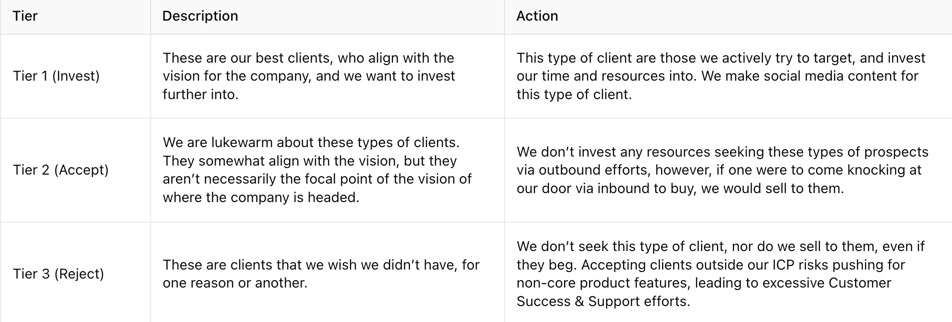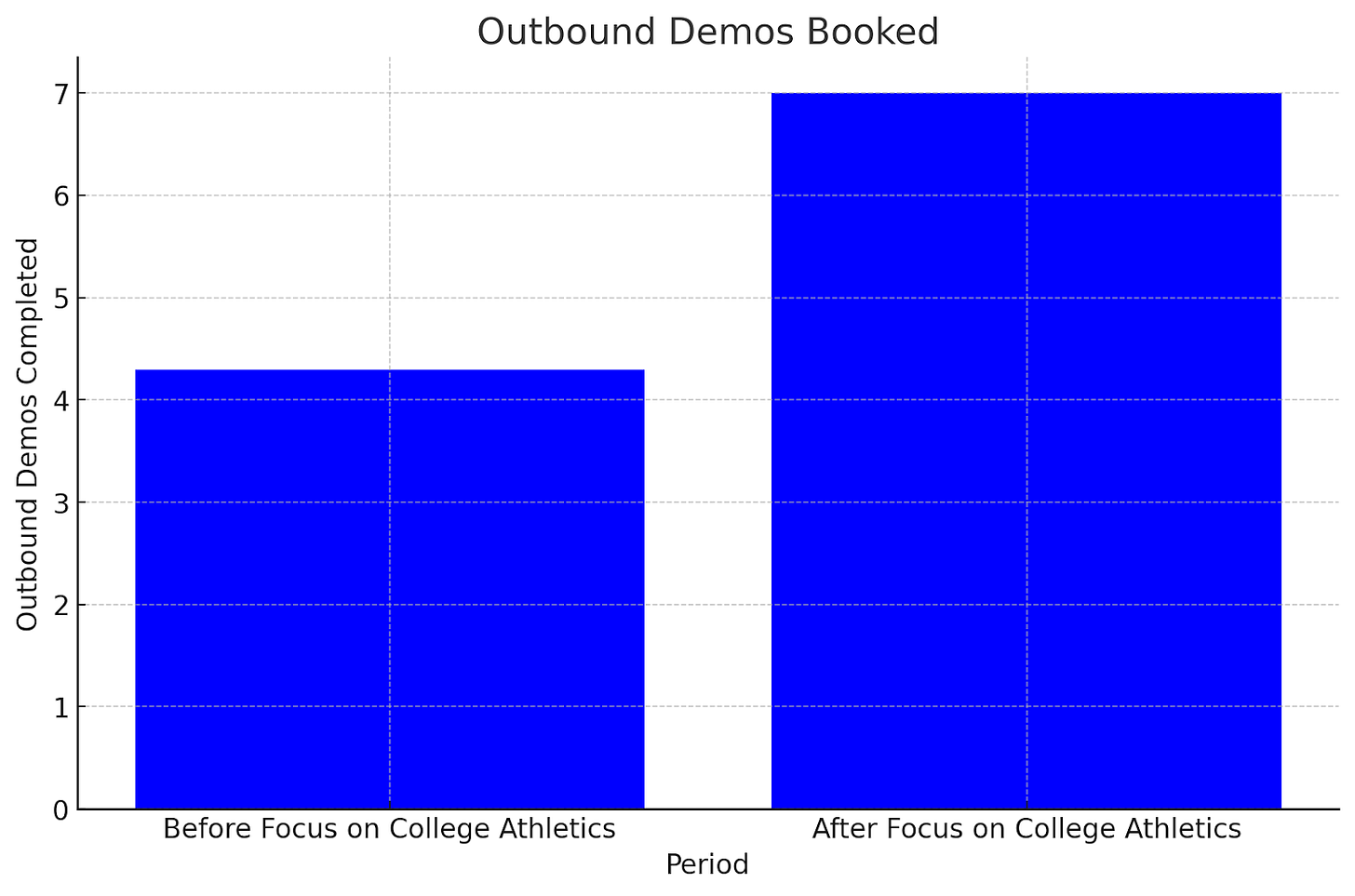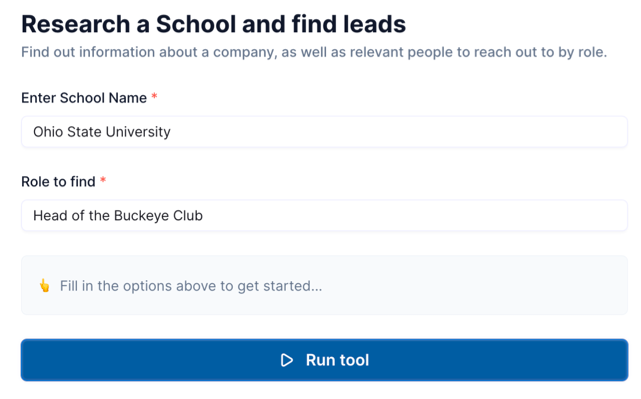“When you have the right team, you don’t need a lot. We believe that if we have the right people, we don’t need a lot of them.”—Luca Maestri, CFO of Apple
Summary
With a lean team, my team has competed and won against companies 10x to 40x our size - by refining our ICP and leveraging AI tools to automate repetitive tasks like lead generation and outbound research.
These changes doubled our monthly sales meetings, improved close rates from 5% to 25%, and freed up time for high-value activities like engaging directly with prospects and customers.
By prioritizing early adopters and refining our sales process, we’ve built a scalable model to compete without increasing headcount.
The 3-Person Unicorn
At Insider Inbox, we are competing and winning mid-6-figure, multi-year contracts with leading college athletic departments in the nation with a company of 5 employees, often competing against companies of 50+ employees.1
During a Y Combinator Lightcone Podcast episode, the possibility of AI Agents eventually replacing entire teams was discussed—and how a 10-person unicorn may be being built right now by a lean team all writing AI Agent prompts. The blog post “The 3-Person Unicorn Startup” posted on NFX mirrors a similar sentiment.
I’m not saying that we’re building the next 5-person unicorn. But with a team of 5, we’re competing (and winning) market share in an industry where our competitors have anywhere from 50-200 employees.
Getting to PMF & Dialed In ICP
During our first year, we had over 100 exploratory conversations with prospects across several different industries to understand their specific pain points. After each meeting, I relayed the most important insights to our product team, who turned these insights into product features, ordered by priority.
Using this approach—and to the product team’s credit—they built a donor communication platform that provided a lot of value to the right organization. But with a 2-man sales team, we initially struggled to find a way to sell it at scale since we consistently spread ourselves too thin.
We needed to dial in our Ideal Customer Profile (ICP) and focus our messaging. Do more by doing less. More specifically knowing who to say “no” to.2
We looked at our current client list–which was a massive spread across several adjacently related industries—non-profits, marketing agencies, some small businesses, public universities, and several college athletic departments.
So we took a step back to figure out which of those clients were most successful, and where we saw the future of the company. We drew a bullseye on a plain sheet of printer paper, and placed our 12 clients at the time on the chart, with Tier 1 in the bullseye.

During this exercise, we had just 4 clients in our ‘invest’ category. Once we had our ICP dialed in, the next challenge was generating leads.
Having recently signed these clients, there was much opportunity at the time to leverage warm referrals, and therefore, generating leads was initially very spray and pray.

Building Home Grown AI Tools
Selling to bureaucratic public universities with a lean team, we decided to go out and hunt for business, rather than relying on Product Led Growth, or building an inbound lead flow via Marketing. With the decision to rely on outbound sales, we had to get enough sales meetings to give us a chance of generating new business.
At this point, we were still figuring out who the Economic Buyer and Customer Champion should be to get more deals done. Since we were still figuring this out, we opted for an outbound sales flow via cold calling, which gave us immediate feedback from our prospects.3
Every opportunity we got, we embedded AI Agents into every step of our process to accomplish more with less resources. For example, rather than hiring a Sales Operations team, we built AI Agents that scraped for contact data. Instead of adding a team of BDR’s, we built a web scraper that combs industry newsletters, triggering a Slack message when a timely event has occurred at our Tier 1 accounts so that we strike when iron’s hot. We didn’t hire a marketer to generate social content. Instead we use Chat GPT to generate a company newsletter using anonymized inspiration from our sales meeting transcripts.
How We Figured Out Which Processes To Automate With AI Tools
First we made sure everything we do manually are high-value tasks that follow the 80 / 20 principle.
Then we observed where we spend the most time. For us, it was getting contact data, doing account research, and making social content.
Then we assessed which tasks were most worthwhile to automate with AI Tools. For example, creating a historical record of every organization would be great to be as relevant as possible with every account. But, it was a better use of our time to create a simple AI Tool that scrapes industry newsletters and spits out the most relevant accounts for timely outreach.
When building an AI Tools to support a lean team, real people are the tip of the spear. Instead of building a Sales Operations team, we found creative ways to conduct outbound - building an AI scraper that pulls a contact’s email and direct phone rather than using TruePeopleSearch to find mobile numbers, using newsletters to solve the problem of personalization without relevance in outbound emails. AI never actually sent emails. It just made our outbound motion more effective.

Focus On Early Adopters
We ruthlessly focused on early adopters, working that into our messaging in order to ensure that we are only focusing our time into prospects that have a high probability of converting into our first customers.

Despite all this great work on generating some leads, this all means nothing without being able to turn those leads into real revenue for the business.
Turning Leads Into Customers
Initially, turning leads into revenue was initially a struggle. From January to October of 2024, we turned 4.8% of the demos we booked into closed revenue, but this past month of December 2024, we got that up to 25% for the month. Yes, part of it was probably due to the end of year, but we did focus on several specific things that improved our ability to close deals with greater probability.

The most important thing we did early on is automate our outbound process to spend more time on closing. Rather than relying on cold calling, which is extremely effective when done right—we automated our outbound meeting booking process using an AI Tool that scrapes the web for relevant leads to reach out to.4
By having our research and sales planning to us by an AI Tools:
We spend less time doing manual research, not talking to prospects.
We spend more time focused talking to prospects, and solving their business problems.
During our first 24 months, we constantly iterated our outbound sales process. Over time we learned who we should be talking to, how we should be positioning our product, and slowly building up a book of business we could reference when talking to prospects.
— Grant Varner
We have a 2-person sales team and a 3-person product team. I won’t name the companies we compete against, but according to LinkedIn, two of our top competitors each have 50 employees (10x our headcount) and 200 employees (40x our headcount).
‘Thank You’ to Kyle Norton for many of his opinions on customer quality. His talk on “How to build GTM Efficiency in SMB Sales” on the Saastr YouTube channel for his talk on focusing on customer quality before customer quantity, until the unit economics are in a good place (i.e. reduce churn). When they did this at Owner.com, they turned down 40% of deals they would have accepted prior. This topic starts at about 11:30.
Check out the ACQ2 Episode “Retool CEO David Hsu on Finding Product-Market Fit via Sales” to hear more about how Retool’s CEO discuss the dangers of product-led growth before you know whether you have product/market fit or not. He talks about how product/market fit is only discoverable by sales (talking to customers). That said, PLG can be efficient after you have product/market fit, but for startups, talking to customers is the best way of figuring that out, and that’s exactly how Retool found product/market fit. The topic starts at 3:52.If you’re found this post valuable, share it with a friend, and consider subscribing if you haven’t already.
For more information about cold calling, I highly recommend watching “52 Minutes of Proven Cold Calling Tips” by 30 Minutes to President’s Club.

